What are the connections between the novel coronavirus and the climate crisis? Margaret is the first speaker on a panel sponsored by UCC Council for Climate Justice, convened on April 1, 2020, by the Rev. Brooks Berndt, PhD (Minister for Environmental Justice, UCC). Other panelists include the Rev. Dr. Leah Schade (Assistant Professor of Preaching and Worship, Lexington Theological Seminary), the Rev. Dr. Jim Antal (Special Advisor on Climate Justice to UCC General Minister and President), and Penny Hooper (Leadership Council Chair, North Carolina Interfaith Power & Light)
creation care
Earth Day 2020 comes at a tumultuous time. COVID-19 has upended our lives. The number of infections keeps soaring world-wide and entire countries are sheltering in place.
Out of caution, many are keeping physical distance from each other. But out of compassion, many are helping any way they can — staying connected by phone or internet with those who are lonely; sewing masks for desperate health care workers; making donations to groups that help migrants and the homeless; pushing for policies that protect the lowest-earning members of society.
If there was ever a time in which humanity should finally recognize that we belong to one connected family on Earth, this should be it. We share a single planet, drink from the same water and breathe the same air.
So, whether hunkered down at home or hospital, or working on the front lines, we are all doing our part to face a common enemy together. When COVID-19 is finally behind us, instead of returning to normal life, we must hold on to these lessons in the fight against climate change.
Below are 6 lessons the coronavirus pandemic can teach us about our response to climate change.
- Science matters
We can save lives by funding, accessing and understanding the best science available. The science on climate change has been clear for decades, but we’ve failed in communicating the danger to the public, leading to slow action and widespread denial of the facts.
- How we treat the natural world affects our well-being.
The loss of habitat and biodiversity creates conditions for lethal new viruses and diseases like COVID-19 to spill into human communities. And if we continue to destroy our lands, we also deplete our resources and damage our agricultural systems.
- The sooner we mobilize for action, the less suffering will take place.
Quick and drastic action can flatten the curve for coronavirus and free up healthcare resources, lowering death rates. Similarly, drastic action on climate change could reduce food and water shortages, natural disasters and sea level rise, protecting countless individuals and communities.
- We have the ability to make drastic changes very quickly.
When sufficiently motivated, we can suspend business as usual to help each other. All over the world, healthy people are changing their lifestyles to protect the more vulnerable people in their communities. Similar dedication for climate change could transform our energy consumption immediately. All of us can make a difference and play an important role in the solution.
- All of us are vulnerable to crisis, though unequally.
Those with underlying social, economic or physical vulnerabilities will suffer most. A society burdened with social and economic inequality is more likely to fall apart in a crisis. We must also recognize that industries and people who profit from an unjust status quo will try to interrupt the social transformation that a crisis requires.
- Holding on to a vision of a just, peaceful and sustainable Earth will give us strength for the future.
Earth Day 2020 will be remembered as a time when humanity was reeling from a pandemic. But we pray that this year will also be remembered as a time when we all were suddenly forced to stop what we were doing, pay attention to one another and take action.
Business as usual — digging up fossil fuels, cutting down forests and sacrificing the planet’s health for profit, convenience and consumption — is driving catastrophic climate change. It’s time to abandon this destructive system and find sustainable ways to inhabit our planet.
What would it look like if we emerged from this pandemic with a fierce new commitment to take care of each other? What would it look like to absorb the lessons of pandemic and to fight for a world in which everyone can thrive?
On this 50th anniversary of Earth Day, as fear and illness sweep the globe, we listen for voices that speak of wisdom, generosity, courage and hope. And as always, we find solace in the natural world. In the suddenly quiet streets and skies, we can hear birds sing.
——————————————————————————————————————————————
This essay was co-written by Margaret Bullitt-Jonas and Leah D. Schade, co-editors of the book Rooted and Rising: Voices of Courage in a Time of Climate Crisis (Rowman & Littlefield, 2019), an anthology of essays from religious environmental activists on finding the spiritual wisdom for facing the difficult days ahead. This essay was published by Earth Day Network on March 25, 2020.
The following sermon for the Second Sunday after Christmas Day is adapted from a sermon I delivered in 2011. It is posted at SustainablePreaching.org (January 5, 2020).
Sermon for the Second Sunday after Christmas Day
Jeremiah 31:7-14
Psalm 84: 1-8
Ephesians 1:3-6, 15-19
Matthew 2: 1-12
Journeying with the wise men
Happy are the people whose strength is in you! whose hearts are set on the pilgrims’ way. – Psalm 84:4
When I think of the three kings, what leaps first to mind are the crèches I unpack every year a couple of weeks before Christmas. On the piano in the living room I put the tall, earthenware figures of Mary, Joseph, and the baby, of the shepherds and sheep, and — yes — of the three kings and their camels. On the mantelpiece goes a miniature nativity set in which each teeny-tiny figure is made of clay, delicately painted, and no more than one inch high. On the coffee table I put the plastic figures and the cheap wooden stable that children can play with to their heart’s content without making their grandmother worry that something will break. No crèche is complete without its three kings, and when the Twelve Days of Christmas are over, back go the kings and camels into their boxes, where they spend the rest of the year stored in the basement.
Reflecting on today’s Gospel, I got to thinking: what would happen if the wise men walked out of those crèches and into our lives? What would happen if these figures — so easy to trivialize as nothing more than decorative props for a mid-winter festival that we pack away when the festival is done — what if the wise men actually came to life for us? What if their journey informed and deepened our own spiritual search, and propelled it forward? So I began to read the story for its spiritual significance, wondering if it might be read as a sacred, archetypal story about how we grow in intimacy with God.
Four parts of the story stand out to me.
First, of course, is the star, that mysterious, shining presence that startles the wise men and launches their search. Ancient tradition held that an unusual star could appear in the skies to mark the birth of someone special, such as a king. That is how the wise men interpret what they see: something out of the ordinary is taking place, something truly significant is afoot, and out the door they go, leaving their ordinary lives behind as they follow the light wherever it leads.
Let’s pause to note that even though every painting, movie, and Christmas card that depicts the journey of the wise men shows a dazzling star above their heads, we don’t actually know from the biblical story whether anyone but the wise men can see that star. King Herod, the chief priests and scribes don’t seem to know anything about the star until the wise men arrive in Jerusalem and tell them about its rising. So the star may be visible to the eye or it may be perceptible only to one’s inward sight; it may be seen or it may be unseen. Either way, it signals the birth of something new in the world. It heralds a presence and power just now being born. The wise men are wise because they spot the star and set everything aside to follow where it leads.
Maybe every spiritual journey begins with a star. At some point we get a sense — perhaps a very vague one — that there is something more to life than the ordinary round of tasks and responsibilities, something above, beyond, or maybe within material reality that can give a larger meaning and purpose to our days, something that is beautiful and shining and that lights up the world. So we set out on a quest to follow that star and to see where it leads. We may name the quest in different ways — maybe we call it a search for meaning or wholeness, a search for happiness or peace. Maybe we seek to know that we are loved, or to draw closer to the divine Source of love. Maybe, as some Greeks say to Philip in the Gospel of John, we express our desire in a simple, straightforward way: “We wish to see Jesus” (John 12:21). However we name that desire, deep down we want to know God. And so, like the wise men, we set out, and what beckons us forward is a star, a subtle, shining presence that keeps company with us, and that we follow as best we can.
For most of us, most of the time, following the leadings of God is not like having a GPS in the car, delivering clear-cut instructions: “Turn left in .2 miles; take the freeway; turn right in 4.3 miles.” Like it or not, the star of Bethlehem is more elusive than that, so we have to develop a stance of careful listening and open inquiry, and a practice of prayer that makes us more sensitive to the glimmers of the holy. It takes practice to stay attentive to the star, for, as Boris Pasternak once wrote, “When a great moment knocks on the door of your life, it is often no louder than the beating of your heart, and it is very easy to miss it.”
The star is the first thing that catches my attention in this story. The second is Jerusalem. Where does the star lead the wise men? Straight to Jerusalem, straight into the center of political and economic power, where King Herod the Great, a client king appointed by Rome, rules with the same ferocity that Stalin wielded over his own country in the 1930’s. We might wish that following a spiritual path were only an individual and interior enterprise — that following the star meant nothing more than developing a personal practice of prayer or going away on periodic retreats. There are plenty of contemporary books and speakers out there that define spirituality in a very individualistic way as being mindful of your own mind and cultivating your own soul — and of course that is definitely part of the journey. But right from the beginning, from the very moment that Christ is born, it’s clear that following his star also means coming to grips with the social and political realities of one’s time. Being “spiritual,” for Christians, is not just an interior, individual project of “saving your soul” — it also has a civic dimension, a political dimension, and as the wise men faithfully follow the star, they are drawn straight into the darkness and turmoil of the world, where systemic power can be used to dominate and terrify. Without intending it or knowing it, the wise men even contribute to Herod’s program of terror, for Herod takes the information that they give him and uses it to order the slaughter of all the children under the age of two who live in Bethlehem.
Following the star evidently means being willing to become conscious of the darkness of the world, and even to perceive how we ourselves are implicated in that darkness. The taxes I pay help subsidize fossil fuels; the clothes I wear and the electronic devices I use may have a vast but hidden social and environmental cost. If I drive a gas-powered car, with every turn of the ignition key, I add to global warming. Until I recognize how I am caught up in and contribute to the contradictions and injustices of our political and economic system, I am not following the star and accompanying the wise men into Jerusalem.
And let’s notice, too, that King Herod trembles at news of the star — in fact, its rising frightens him. The powers that be are terrified when God in Christ draws near, for God’s love is always a threat to those powers; it opposes everything in us and around us that is selfish, greedy, and motivated by the wish to dominate, control, and possess. As I read it, the wise men needed to get to know those powers, both within themselves and in the world around them, if they were going to find and follow Christ.
So they entered Jerusalem and faced the darkness. Then, keeping their eyes on the star, they kept going, “until it stopped over the place where the child was. When they saw that the star had stopped, they were overwhelmed with joy” (Matthew 2:9b-10).
This is the third part of the story: the encounter with Christ. What a beautiful line that is — “when they saw that the star had stopped, they were overwhelmed with joy.” The long, long journey with all its uncertainties and privations, its cold nights and its restless, ardent searching, has reached its fulfillment. The star has stopped, and the wise men can be at peace at last, they have arrived at last, they have found what they were looking for, at last! They enter the house, they see Mary and the child, and they fall to their knees in a gesture of deep reverence and humility.
Do we know what that’s like? Of course we do. We glimpse such moments whenever time seems to stop, when, for instance, our minds grow very quiet in prayer, we surrender our thoughts, and we seem to be filling with light. Or maybe it happens when we gaze at something that captures our complete attention — maybe a stretch of mountains or the sea, or when we take a long, loving look into a child’s sleeping face, or when we are completely absorbed in a piece of music. In moments like these, it can feel as if we are gazing through the object on which we gaze, and seeing into the heart of life itself. Love is pouring through us and into us, and all we can do is throw up our hands, fall inwardly to our knees, and offer as a gift everything that is in us, just as the wise men open their treasure chests and offer everything that is in them. Worship is what happens when we come into the presence of what is really real. When we come to the altar rail at the Eucharist, whether we choose to stand or whether we kneel as the wise men did, like them we stretch out our hands to offer everything that is in us, and like them we receive — we take in — the living presence of Christ.
Finally, the fourth part of the story is its closing line: “… having been warned in a dream not to return to Herod, they left for their own country by another road” (Matthew 2:12). In other words, the wise men refused to cooperate with Herod. They deceived him. They resisted him. The wise men have been called the first conscientious objectors in the name of Christ. They are the first in a long line of witnesses to Christ who from generation to generation have carried out acts of non-violent civil disobedience in Jesus’ name. The journey of the wise men is our journey, too, for, as Gregory the Great reportedly remarked in a homily back in the 7th century: “Having come to know Jesus, we are forbidden to return by the way we came.”
So, as we set out together into a new year, I hope that you will join me in keeping the wise men at our side, rather than packing them away somewhere in a box.
Like them, we can attune ourselves to the guiding of the star and renew our commitment to prayer and inward listening.
Like them, we can enter Jerusalem and all the dark places of our world and soul, following where God leads, and trusting that God’s light will shine in the darkness.
Like them, we can make our way to Christ, and kneel in gratitude.
And like them, we, too, can rise to our feet with a new-fired passion to be agents of justice and healing, and a renewed desire to give ourselves to God, for “happy are the people whose strength is in [God, and] whose hearts are set on the pilgrims’ way.”
A sacramental life: Rising up to take climate action
Friends, it is a blessing to be with you. Before I say another word I want to thank the many people who helped turn this windowless hotel room into a sacred space. Because of their creativity and generosity, we have four stunning new banners that represent elements of the natural world – banners that we hope you will borrow to use in your own church1 – and we have a baptismal font adorned with nature’s beauty. Thank you – and thanks to everyone who had a hand in creating this service. I especially want to thank Geoffrey Hudson, composer of “A Passion for the Planet” and the musicians and members of Illuminati Vocal Arts Ensemble who are here to bring this music to life.
I am particularly moved to see the image of Earth placed on our altar. As you may remember, this photograph was taken in December 1972, by the crew of the Apollo 17 spacecraft on its way to the moon. It’s called the “Blue Marble” because when the crew looked out the window, around 18,000 miles from the surface of the planet, the Earth was about the size of a marble. You could cover it with your thumb. Everything we know and love, every part of human history and experience is on that precious marble whirling in the darkness of space. That photo gave us our first glimpse of Earth as a whole, allowing us to see for the first time its unity, its fragility and vulnerability, and its preciousness. This flag has traveled with me to countless climate marches and rallies, and it touches me to bring it home to this altar, to lay it on this table where in every Eucharist we remember “God so loved the world” (John 3:16) that God loved into being, redeems in Jesus Christ, and sustains by the power of the Holy Spirit!
This is a good time to uphold the Earth in prayer, for we know that the living world is in a precarious state. Last year the World Wildlife Fund released a report showing that globally the number of animals has plummeted by over half in less than 50 years. Humans have wiped out 60% of the world’s mammals, reptiles, amphibians, birds, and fish since 1970. We are in the midst of what alarmed scientists are calling a “biological annihilation.” One expert commented: “This is far more than just being about losing the wonders of nature, desperately sad though that is…This is actually now jeopardizing the future of people. Nature is not a ‘nice to have’ – it is our life-support system.”
Then came a major report from the U.N.’s Intergovernmental Panel on Climate Change, which showed that planetary warming is well underway and that time is running out to avert climate catastrophe. Because of the burning of coal, gas, and oil, and the logging of forests, our planet keeps breaking records for heat. Of course it is the poor and racial minorities and the historically marginalized that suffer first and hardest from the shocks and disruptions of climate change, although in the end, all of us will be affected. Earlier this week more than 11,000 scientists from around the world issued a report that warns of “untold suffering” if we don’t change course fast. Scientists are generally a cool-headed, understated lot, right? So it’s worth noticing when for the first time a large group of scientists calls climate change an emergency. Last year’s IPCC report told us that in order to avoid runaway climate change we must carry out a radical transformation of society, from top to bottom, at a scale and pace that is historically unprecedented: today we have maybe eleven years in which to set a new course and to cut our emissions in half from their levels in 2010. Never before in human history has our species changed its way of living that dramatically and that fast.
This flag has traveled with me to countless climate marches and rallies, and it touches me to bring it home to this altar, to lay it on this table where in every Eucharist we remember “God so loved the world” (John 3:16) that God loved into being, redeems in Jesus Christ, and sustains by the power of the Holy Spirit!
This is a good time to uphold the Earth in prayer, for we know that the living world is in a precarious state. Last year the World Wildlife Fund released a report showing that globally the number of animals has plummeted by over half in less than 50 years. Humans have wiped out 60% of the world’s mammals, reptiles, amphibians, birds, and fish since 1970. We are in the midst of what alarmed scientists are calling a “biological annihilation.” One expert commented: “This is far more than just being about losing the wonders of nature, desperately sad though that is…This is actually now jeopardizing the future of people. Nature is not a ‘nice to have’ – it is our life-support system.”
Then came a major report from the U.N.’s Intergovernmental Panel on Climate Change, which showed that planetary warming is well underway and that time is running out to avert climate catastrophe. Because of the burning of coal, gas, and oil, and the logging of forests, our planet keeps breaking records for heat. Of course it is the poor and racial minorities and the historically marginalized that suffer first and hardest from the shocks and disruptions of climate change, although in the end, all of us will be affected. Earlier this week more than 11,000 scientists from around the world issued a report that warns of “untold suffering” if we don’t change course fast. Scientists are generally a cool-headed, understated lot, right? So it’s worth noticing when for the first time a large group of scientists calls climate change an emergency. Last year’s IPCC report told us that in order to avoid runaway climate change we must carry out a radical transformation of society, from top to bottom, at a scale and pace that is historically unprecedented: today we have maybe eleven years in which to set a new course and to cut our emissions in half from their levels in 2010. Never before in human history has our species changed its way of living that dramatically and that fast.
 So that’s where we find ourselves: on a beautiful, precious, but ailing planet, with the web of life unraveling before our eyes and only a short time in which to heal our ecosystems and create a more just and sustainable way of life. Well, when you hear stark news like that, it’s easy to shut down. It’s hard to face the grief, helplessness, and fear that our situation evokes. When we feel powerless to imagine, much less to create, a better future, we tend to put our heads down and carry on with business as usual, even if business as usual is wrecking the planet.
I’m very interested in how we move out of fear, inertia, and despair and into the movement to tackle climate change and social inequality – so interested, in fact, that a friend and I asked colleagues in the faith-and-environment movement to write about their sources of spiritual strength. What gives them courage? What gives them hope? Our anthology of essays, Rooted and Rising: Voices of Courage in a Time of Climate Crisis, has just been published. So I ask you: Where do you find courage to take action, even when the forces against us are great? What are your sources of strength and resilience in a perilous time?
As for me, I draw strength from the living presence of Jesus Christ within us and among us. “I came that they may have life,” Jesus says to us today, “and have it abundantly” (John 10:10). That’s a mission statement: he came then and he comes now to bring life – and not any old life, but a life that is lit up with meaning and purpose, a life that is animated by a fierce love that seeks to create a beloved community in which people live in harmony with God, with each other, and with the whole of God’s Creation.
So that’s where we find ourselves: on a beautiful, precious, but ailing planet, with the web of life unraveling before our eyes and only a short time in which to heal our ecosystems and create a more just and sustainable way of life. Well, when you hear stark news like that, it’s easy to shut down. It’s hard to face the grief, helplessness, and fear that our situation evokes. When we feel powerless to imagine, much less to create, a better future, we tend to put our heads down and carry on with business as usual, even if business as usual is wrecking the planet.
I’m very interested in how we move out of fear, inertia, and despair and into the movement to tackle climate change and social inequality – so interested, in fact, that a friend and I asked colleagues in the faith-and-environment movement to write about their sources of spiritual strength. What gives them courage? What gives them hope? Our anthology of essays, Rooted and Rising: Voices of Courage in a Time of Climate Crisis, has just been published. So I ask you: Where do you find courage to take action, even when the forces against us are great? What are your sources of strength and resilience in a perilous time?
As for me, I draw strength from the living presence of Jesus Christ within us and among us. “I came that they may have life,” Jesus says to us today, “and have it abundantly” (John 10:10). That’s a mission statement: he came then and he comes now to bring life – and not any old life, but a life that is lit up with meaning and purpose, a life that is animated by a fierce love that seeks to create a beloved community in which people live in harmony with God, with each other, and with the whole of God’s Creation.
 Jesus, the Good Shepherd of our souls, lived close to the earth. He walked in the desert and along the shores of a lake. He felt the wind on his face and he watched the night stars. He climbed mountains to pray, and in his teaching and parables he used earthy images of vines and bread and seeds, of lilies and sheep. Jesus was steeped in the rhythms of the natural world, and maybe it’s no accident that when Mary caught her first glimpse of the Risen Christ, she mistook him for the gardener.
In a time of climate crisis, we are blessed to meet the Good Shepherd in every celebration of the Eucharist. This is where we find strength for the journey and where our moral courage is renewed. Maybe we should think of Holy Communion as our superpower. God has so much to give us and to show us in this sacrament!
For starters, Communion is good practice for living well on the Earth.2 As we heard in the reading from Wendell Berry, everyone lives by eating. The question is whether or not we ruthlessly grab and grasp, turning into greedy “consumers” who must constantly replenish ourselves with material things in order to reassure ourselves that we’re powerful, that we matter, and that we exist.
Holy Communion is a radically counter-cultural practice that can heal unholy consumerism. We savor a morsel of bread, take a small sip of wine, and in our attentive reverence to Christ’s presence, we are filled. We share one loaf and one cup, and there is enough for everyone. In every Eucharist we discover to our amazement that in taking only what we need and in sharing what we have, our hearts our satisfied.
What’s more – every Communion also reminds us how much God loves the whole Creation, not just human beings – as if we happen to be the only species that God cares about. When the celebrant lifts up the bread and wine during Holy Communion, all of Creation is lifted up. When the celebrant blesses the bread and wine, all of Creation is blessed. The consecrated bread that is placed in our hands is made of wheat, earth and sunlight, of rainwater and clouds, of farmers’ hands and human labor. When we stretch out our hands to receive the bread, we take in what is natural and we take in Christ.
The bishops of New England described it like this in a Pastoral Letter3 a while back: when “we nourish ourselves at the Eucharistic table… Christ gives himself to us in the natural elements of bread and wine, and restores our connections not only with God and one another, but also with the whole web of creation.”
We are making that crystal clear in our prayers today, so you will notice that in the prayer after Communion, we have added five words. We will pray, as we usually do: God of abundance, you have fed us with the bread of life and cup of salvation; you have united us with Christ and one another; and you have made us one with all your people in heaven and on earth, and then come five new words: “and with your whole Creation.”
Why is this important? Because we come to this table so that everything in us and around us can be lifted up and blessed, so that everything in us and around us can be caught up in the redeeming love of God – not only we ourselves, and not only the bread and the wine, but also the whole of God’s Creation, every leaf of it and every speck of sand. In every Eucharist we bring the Earth to the altar. We offer the world to God. And when we leave this table, we’ve been filled with the divine love that reconciles all things on heaven and Earth and that strengthens us to join God in healing and protecting our precious, wounded world.
When it comes to tackling the climate crisis, there are many actions that we can take as individuals and as communities of faith! I’m not going to list them here, because we’ve distributed a handout of suggestions and because the resolution we’ll discuss this afternoon is also full of suggestions. But I will say this: Now is the time to preach boldly about the climate crisis. Now is the time to take clear and courageous action to safeguard the web of life that God entrusted to our care. Now is the time to join the climate justice movement and to bear witness to the Christ who bursts from the tomb and who proclaims that life and not death will have the last word.
“I have come that they may have life, and have it abundantly.”
Will we be successful? Will we avert runaway climate change? I don’t know. But I do know that every choice matters. Every degree of temperature-rise matters. I’m told that “even a tenth of a degree Celsius means the difference between life and death for millions of people.”
I may have the title, “Missioner for Creation Care,” but I hold that title on your behalf. Each of you – everyone in this room, every single one of you – you too are missioners for Creation care, because you, too, are fed at this table where we meet the life-giving and liberating and reconciling presence of Jesus Christ.
Jesus, the Good Shepherd of our souls, lived close to the earth. He walked in the desert and along the shores of a lake. He felt the wind on his face and he watched the night stars. He climbed mountains to pray, and in his teaching and parables he used earthy images of vines and bread and seeds, of lilies and sheep. Jesus was steeped in the rhythms of the natural world, and maybe it’s no accident that when Mary caught her first glimpse of the Risen Christ, she mistook him for the gardener.
In a time of climate crisis, we are blessed to meet the Good Shepherd in every celebration of the Eucharist. This is where we find strength for the journey and where our moral courage is renewed. Maybe we should think of Holy Communion as our superpower. God has so much to give us and to show us in this sacrament!
For starters, Communion is good practice for living well on the Earth.2 As we heard in the reading from Wendell Berry, everyone lives by eating. The question is whether or not we ruthlessly grab and grasp, turning into greedy “consumers” who must constantly replenish ourselves with material things in order to reassure ourselves that we’re powerful, that we matter, and that we exist.
Holy Communion is a radically counter-cultural practice that can heal unholy consumerism. We savor a morsel of bread, take a small sip of wine, and in our attentive reverence to Christ’s presence, we are filled. We share one loaf and one cup, and there is enough for everyone. In every Eucharist we discover to our amazement that in taking only what we need and in sharing what we have, our hearts our satisfied.
What’s more – every Communion also reminds us how much God loves the whole Creation, not just human beings – as if we happen to be the only species that God cares about. When the celebrant lifts up the bread and wine during Holy Communion, all of Creation is lifted up. When the celebrant blesses the bread and wine, all of Creation is blessed. The consecrated bread that is placed in our hands is made of wheat, earth and sunlight, of rainwater and clouds, of farmers’ hands and human labor. When we stretch out our hands to receive the bread, we take in what is natural and we take in Christ.
The bishops of New England described it like this in a Pastoral Letter3 a while back: when “we nourish ourselves at the Eucharistic table… Christ gives himself to us in the natural elements of bread and wine, and restores our connections not only with God and one another, but also with the whole web of creation.”
We are making that crystal clear in our prayers today, so you will notice that in the prayer after Communion, we have added five words. We will pray, as we usually do: God of abundance, you have fed us with the bread of life and cup of salvation; you have united us with Christ and one another; and you have made us one with all your people in heaven and on earth, and then come five new words: “and with your whole Creation.”
Why is this important? Because we come to this table so that everything in us and around us can be lifted up and blessed, so that everything in us and around us can be caught up in the redeeming love of God – not only we ourselves, and not only the bread and the wine, but also the whole of God’s Creation, every leaf of it and every speck of sand. In every Eucharist we bring the Earth to the altar. We offer the world to God. And when we leave this table, we’ve been filled with the divine love that reconciles all things on heaven and Earth and that strengthens us to join God in healing and protecting our precious, wounded world.
When it comes to tackling the climate crisis, there are many actions that we can take as individuals and as communities of faith! I’m not going to list them here, because we’ve distributed a handout of suggestions and because the resolution we’ll discuss this afternoon is also full of suggestions. But I will say this: Now is the time to preach boldly about the climate crisis. Now is the time to take clear and courageous action to safeguard the web of life that God entrusted to our care. Now is the time to join the climate justice movement and to bear witness to the Christ who bursts from the tomb and who proclaims that life and not death will have the last word.
“I have come that they may have life, and have it abundantly.”
Will we be successful? Will we avert runaway climate change? I don’t know. But I do know that every choice matters. Every degree of temperature-rise matters. I’m told that “even a tenth of a degree Celsius means the difference between life and death for millions of people.”
I may have the title, “Missioner for Creation Care,” but I hold that title on your behalf. Each of you – everyone in this room, every single one of you – you too are missioners for Creation care, because you, too, are fed at this table where we meet the life-giving and liberating and reconciling presence of Jesus Christ.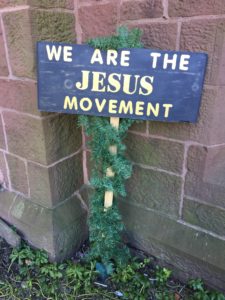 I’d like to end with a story about risking arrest for the first time and what it taught me about the Eucharist. Back in 2001 I was desperate to find a way to address the climate crisis, and I decided to join a new interfaith group, Religious Witness for the Earth, which was gathering in Washington, D.C., to protest the Administration’s energy policy and its plan to drill for more oil in the Arctic.
Here’s what happened: On the first day we learned about oil drilling and the Arctic, about climate change and fossil fuels. On the second we lobbied our members of Congress and studied the disciplines of non-violent civil disobedience. On the third, about a hundred of us marched down Independence Avenue in religious vestments, carrying banners and singing. When we reached the Department of Energy, an enormous stone structure surrounded by police, we held a brief worship service. So far, everything was legal. Then came the part that wasn’t. I’ll read from an essay I wrote4 about what that was like.
The worship service was coming to an end. We sang “Amazing Grace,” and then the twenty-two of us who had decided to risk arrest joined hands and walked slowly to the doors of the Department of Energy.
I felt us cross an invisible boundary. With the others, I stepped over a threshold I could not see. I walked out of my ordinary life.
I am neither a law-breaker nor a thrill-seeker. More often than not, I follow the rules – even enforce them. I fasten my seat belt, don’t cheat on taxes, write thank you notes, and stand up when the band plays our national anthem. But here I was, intentionally and publicly breaking the law. As if some inner revolution had quietly taken place, the old “me” was no longer in charge. Whatever security I’d felt in operating within the rules was gone. That’s partly why I felt so frightened as I left the safety of the circle and moved toward the door: I hardly recognized myself. I hardly knew who I was.
§§
We stand or kneel in prayer, our backs to the building.
The pavement under my knees is hard. At home, I often sit on a meditation cushion to pray. Today there is no cushion, just the weight of my body against stone. I lift up my hands. I’m dressed for Holy Communion. I might as well hold out my arms as I do at Communion.
Instead of pews filled with parishioners, I see ranks of police and a cluster of supporters. I am afraid. I’ve never been arrested before. Years ago, as a VISTA volunteer in Mayor Rizzo’s Philadelphia I heard countless stories of police brutality. It’s not that I really expect the same thing to happen to me – the punch in the gut, the assault behind closed doors. Still, my body tenses as I place myself against the cops, the Feds, the law.
I close my eyes. One by one we pray aloud, words thrown into space, words hurled against stone.
Is this whole thing ridiculous? I briefly open my eyes and notice a well-dressed man watching us. He strokes his tie, leans over and says something to a fellow nearby. The two of them chuckle. I have no idea what they’re talking about but I wonder if they think we look absurd. I suppose we do. Here we are with our jerry-rigged signs, our predictably earnest songs and prayers of protest, a foolhardy band straight out of the ‘60’s.
Defensively, I imagine confronting that mocking man with the arsenal of our credentials. “We’re no rag-tag bunch,” I want to tell him. “We’re people with doctorates and master’s degrees – nurses and ministers, writers and accountants. Thoughtful people, educated people, professionals.”
I am distracted from prayer by this indignant outburst. “Let it go,” wisdom tells me. “None of that matters — your degrees, your skills, your status in the world. The privileges of race and class mean nothing now. You’re a woman on your knees, that’s who you are — one human being pleading with God.”
I turn my attention back to prayer and continue to stretch out my arms. Suddenly I realize that beneath the tension, beneath the fear and self-consciousness, something else is welling up. I am jubilant.
“Lift up your hearts,” I might as well be saying to the people before me, beaming as broadly as I do at Communion.
“We lift them to the Lord,” would come the response.
How did I miss it? After years of going to church, after years of celebrating Communion, only now, as I kneel on pavement and face a phalanx of cops, do I understand so clearly that praising God can be an act of political resistance. That worship is an act of human liberation. The twenty-two of us come from different faith traditions, but each of us is rooted in a reality that transcends the rules and structures of this world. Tap into that transcendent truth, let the divine longing for a community of justice and mercy become your own deepest longing, and who knows what energy for life will be released?
I feel as defiant as a maple seedling that pushes up through asphalt. It is God I love, and God’s green earth. I want to bear witness to that love even in the face of hatred or indifference, even if the cost is great.
So what if our numbers are small? So what if, in the eyes of the police, in the eyes of the world, we have no power? I’m beginning to sense the power that is ours to wield, the power of self-offering. We may have nothing else, but we do have this, the power to say, “This is where I stand. This is what I love. Here is something for which I’m willing to put my body on the line.”
I never knew that stepping beyond the borders of what I find comfortable could make me so happy. That shifting from self-preservation to self-offering could awaken so much joy.
I invite you to take a moment to remember a time when you took a brave step toward fullness of life, a time when you made a decision to do the right thing, even though you knew it would be difficult or costly. Who inspires you to be bolder than you thought? With whom do you hold hands, literally or figuratively, when you step out to make a difference in the world? And if you knew you could not fail – if you were set free from fear – what would you do for the healing of our world?
_________________________________________________________________________________________________________
1. If your church in the Diocese of Western Mass. would like to borrow the banners, please contact the Dean of Christ Church Cathedral, the Very. Rev. Tom Callard (413/736-2742, ext. 1; email: tcallard (at) cccspfld.org).
2.This and the following three paragraphs are adapted from “Second Friday of Advent,” Joy of Heaven, To Earth Come Down: Meditations for Advent and Christmas, by Margaret Bullitt-Jonas (Cincinnati, OH: Forward Movement, 2012, 2013), 35-36.
3. “To Serve Christ in All Creation: A Pastoral Letter from the Episcopal Bishops of New England,” issued February 2003.
4. Adapted from “When Heaven Happens” by Margaret Bullitt-Jonas, in Heaven, ed. Roger Ferlo (NY: Seabury Books, 2007), 74-85.
I’d like to end with a story about risking arrest for the first time and what it taught me about the Eucharist. Back in 2001 I was desperate to find a way to address the climate crisis, and I decided to join a new interfaith group, Religious Witness for the Earth, which was gathering in Washington, D.C., to protest the Administration’s energy policy and its plan to drill for more oil in the Arctic.
Here’s what happened: On the first day we learned about oil drilling and the Arctic, about climate change and fossil fuels. On the second we lobbied our members of Congress and studied the disciplines of non-violent civil disobedience. On the third, about a hundred of us marched down Independence Avenue in religious vestments, carrying banners and singing. When we reached the Department of Energy, an enormous stone structure surrounded by police, we held a brief worship service. So far, everything was legal. Then came the part that wasn’t. I’ll read from an essay I wrote4 about what that was like.
The worship service was coming to an end. We sang “Amazing Grace,” and then the twenty-two of us who had decided to risk arrest joined hands and walked slowly to the doors of the Department of Energy.
I felt us cross an invisible boundary. With the others, I stepped over a threshold I could not see. I walked out of my ordinary life.
I am neither a law-breaker nor a thrill-seeker. More often than not, I follow the rules – even enforce them. I fasten my seat belt, don’t cheat on taxes, write thank you notes, and stand up when the band plays our national anthem. But here I was, intentionally and publicly breaking the law. As if some inner revolution had quietly taken place, the old “me” was no longer in charge. Whatever security I’d felt in operating within the rules was gone. That’s partly why I felt so frightened as I left the safety of the circle and moved toward the door: I hardly recognized myself. I hardly knew who I was.
§§
We stand or kneel in prayer, our backs to the building.
The pavement under my knees is hard. At home, I often sit on a meditation cushion to pray. Today there is no cushion, just the weight of my body against stone. I lift up my hands. I’m dressed for Holy Communion. I might as well hold out my arms as I do at Communion.
Instead of pews filled with parishioners, I see ranks of police and a cluster of supporters. I am afraid. I’ve never been arrested before. Years ago, as a VISTA volunteer in Mayor Rizzo’s Philadelphia I heard countless stories of police brutality. It’s not that I really expect the same thing to happen to me – the punch in the gut, the assault behind closed doors. Still, my body tenses as I place myself against the cops, the Feds, the law.
I close my eyes. One by one we pray aloud, words thrown into space, words hurled against stone.
Is this whole thing ridiculous? I briefly open my eyes and notice a well-dressed man watching us. He strokes his tie, leans over and says something to a fellow nearby. The two of them chuckle. I have no idea what they’re talking about but I wonder if they think we look absurd. I suppose we do. Here we are with our jerry-rigged signs, our predictably earnest songs and prayers of protest, a foolhardy band straight out of the ‘60’s.
Defensively, I imagine confronting that mocking man with the arsenal of our credentials. “We’re no rag-tag bunch,” I want to tell him. “We’re people with doctorates and master’s degrees – nurses and ministers, writers and accountants. Thoughtful people, educated people, professionals.”
I am distracted from prayer by this indignant outburst. “Let it go,” wisdom tells me. “None of that matters — your degrees, your skills, your status in the world. The privileges of race and class mean nothing now. You’re a woman on your knees, that’s who you are — one human being pleading with God.”
I turn my attention back to prayer and continue to stretch out my arms. Suddenly I realize that beneath the tension, beneath the fear and self-consciousness, something else is welling up. I am jubilant.
“Lift up your hearts,” I might as well be saying to the people before me, beaming as broadly as I do at Communion.
“We lift them to the Lord,” would come the response.
How did I miss it? After years of going to church, after years of celebrating Communion, only now, as I kneel on pavement and face a phalanx of cops, do I understand so clearly that praising God can be an act of political resistance. That worship is an act of human liberation. The twenty-two of us come from different faith traditions, but each of us is rooted in a reality that transcends the rules and structures of this world. Tap into that transcendent truth, let the divine longing for a community of justice and mercy become your own deepest longing, and who knows what energy for life will be released?
I feel as defiant as a maple seedling that pushes up through asphalt. It is God I love, and God’s green earth. I want to bear witness to that love even in the face of hatred or indifference, even if the cost is great.
So what if our numbers are small? So what if, in the eyes of the police, in the eyes of the world, we have no power? I’m beginning to sense the power that is ours to wield, the power of self-offering. We may have nothing else, but we do have this, the power to say, “This is where I stand. This is what I love. Here is something for which I’m willing to put my body on the line.”
I never knew that stepping beyond the borders of what I find comfortable could make me so happy. That shifting from self-preservation to self-offering could awaken so much joy.
I invite you to take a moment to remember a time when you took a brave step toward fullness of life, a time when you made a decision to do the right thing, even though you knew it would be difficult or costly. Who inspires you to be bolder than you thought? With whom do you hold hands, literally or figuratively, when you step out to make a difference in the world? And if you knew you could not fail – if you were set free from fear – what would you do for the healing of our world?
_________________________________________________________________________________________________________
1. If your church in the Diocese of Western Mass. would like to borrow the banners, please contact the Dean of Christ Church Cathedral, the Very. Rev. Tom Callard (413/736-2742, ext. 1; email: tcallard (at) cccspfld.org).
2.This and the following three paragraphs are adapted from “Second Friday of Advent,” Joy of Heaven, To Earth Come Down: Meditations for Advent and Christmas, by Margaret Bullitt-Jonas (Cincinnati, OH: Forward Movement, 2012, 2013), 35-36.
3. “To Serve Christ in All Creation: A Pastoral Letter from the Episcopal Bishops of New England,” issued February 2003.
4. Adapted from “When Heaven Happens” by Margaret Bullitt-Jonas, in Heaven, ed. Roger Ferlo (NY: Seabury Books, 2007), 74-85.
Choose life for you and your children!
What a joy to be with you! I serve as Missioner for Creation Care in both the Episcopal Diocese of Western Massachusetts and the United Church of Christ in Massachusetts. In this ecumenical role I travel from place to place, sometimes (as you can see) far beyond Massachusetts, speaking about the Gospel call to protect God’s Creation. If you’d like to hear what I’m up to, please take a look at my Website, RevivingCreation.org. I know you’re already taking steps as individuals and as a congregation to safeguard what our Prayer Book calls “this fragile Earth, our island home,” so even though we’ve never met, I feel as if I’m among friends.
We have a fine text to reflect on this morning, the passage in Deuteronomy where Moses speaks to his community and gives them a choice. “I have set before you today life and prosperity, death and adversity. If you obey the commandments of God, by loving God and walking in God’s ways, then you shall live and God will bless you. But if your heart turns away and you do not hear, but are led astray to bow down to other gods and serve them, I declare to you today that you shall perish. Today I have set before you life and death, blessings and curses. Choose life so that you and your descendants may live.”1
1. Paraphrase of Deuteronomy 30:15-20. 2. Bill McKibben, Falter: Has the Human Game Begun to Play Itself Out? (New York: Henry Holt and Company, 2019), 32-33. 3. McKibben, 12. 4. David Wallace-Wells, The Uninhabitable Earth (New York: Tim Duggan Books, Penguin Random House, 2019), 3. 5. Hafiz, quoted by Jack Kornfield, The Art of Forgiveness, Lovingkindness, and Peace (New York: Bantam Books, 2002), 83.
A plumb line in our midst: When we stop pretending about climate change
“This is what the Lord God showed me: the Lord was standing beside a wall built with a plumb line, with a plumb line in his hand. And the Lord said to me, ‘Amos, what do you see?’ And I said, ‘A plumb line’” (Amos 7:7).That interested me, this image of God standing beside a wall, holding up a plumb line to see whether or not the wall was straight and could stand. So I went on the Internet and learned that plumb lines are useful in a great many fields. A plumb line, or something like it, can be essential if you want to build a house or build a ship, or if you want to make a level wall or draw a good map. Carpenters use plumb lines, and so do stonemasons, astronomers and geographers.

Love in a time of climate emergency
We have a wonderful text to reflect on this morning, a passage from the Gospel of John. The scene is the Last Supper, and Jesus is beginning to say goodbye. He knows that his life is about to be cut short and that the next day he will die. So Jesus gathers with his friends for a final meal, and in an act of humble service, he washes their feet. Then, as Judas steps out into the night to betray him, Jesus turns to the gathered circle and says those familiar words: “Little children, I am with you only a little longer. You will look for me; and as I said to the Jews so now I say to you, ‘Where I am going, you cannot come.’ I give you a new commandment, that you love one another. Just as I have loved you, you also should love one another. By this everyone will know that you are my disciples, if you have love for one another” (John 13:13-35).
 These are urgent and tender words, the words of someone facing death and eager to convey what really matters. “Little children, love one another.” I’m told that in John the Evangelist’s old age, that was the basic message he brought to one community of faith after another: “Little children, love one another.” After spending time with Jesus, and after years of meditating on Jesus’ life and teaching, on Jesus’ crucifixion and resurrection, the aging evangelist could find no more direct route into the heart of the Gospel than simply to say, “Little children, love one another.”
This brings to mind a poem by Michael Leunig:1
There are only two feelings. Love and fear.
There are only two languages. Love and fear.
There are only two activities. Love and fear.
There are only two motives, two procedures,
two frameworks, two results.
Love and fear.
Love and fear.
As followers of Jesus, we may be called to love, but I don’t for a moment believe that we’re not also well acquainted with fear. I remember my childhood fears, such as my fear of the monsters lurking under the bed, and how important it was not to let even one toe stick out beyond the edge of the mattress. I remember my fear that when my parents went out at night, they might not come back. I remember my fear of the swarm of bees that nested near the front door; my fear, during piano recitals, that I might forget which note came next; my fear that I might be chosen last for the softball team, or, what’s worse, that the ball might actually come hurtling in my direction and – dreadful thought – all my team-mates would count on me to catch it.
The fears of a child gradually morph into the fears of an adult, and even though we grownups may go to a great deal of trouble not to appear anxious or afraid, most us face some kind of fear every day. Fears come in all shapes and sizes. What are you afraid of? Chances are excellent that several of us fear the same thing. And we know what that’s like: how, when frightened, we hold our breath, our bellies clench and our hearts race.
There’s a lot of fear going around these days, and we have reason to worry. In addition to our personal fears, we feel a collective shudder about the state of the world, from the assault on women’s reproductive rights to the harsh treatment of immigrants. For me, it’s the ecological crisis that wakes me up at night, for scientists are reporting with increasing concern that the web of life is unraveling before our eyes and that human civilization is at risk of collapse. Just think of it: the number of animals around the world has plummeted by over half in less than 50 years, mostly by the development of great swaths of land and the destruction of habitat. Human activity has wiped out 60% of the world’s mammals, reptiles, amphibians, birds, and fish since 1970. Alarmed scientists are describing what they call a “biological annihilation,” and one expert commented: “This is far more than just being about losing the wonders of nature, desperately sad though that is…This is actually now jeopardizing the future of people. Nature is not a ‘nice to have’ – it is our life-support system.” A few weeks ago, a sweeping new report from the U.N. spoke about the possible extinction of as many as one million plant and animal species in the near future.
And then there’s the climate crisis. Burning fossil fuels like coal, gas, and oil is pushing the planet to break new records for heat, causing droughts, floods, and monster hurricanes, drowning cities, and accelerating wildfires. The people hurt first and hardest by the effects of a changing climate are the poor, and unless we change course fast, we will not be able to leave our children and our children’s children a habitable world. The U.N.’s Intergovernmental Panel on Climate Change warns that we have only a very short span of time – maybe 12 years – in which to avert a catastrophic level of global warming worldwide.
These are urgent and tender words, the words of someone facing death and eager to convey what really matters. “Little children, love one another.” I’m told that in John the Evangelist’s old age, that was the basic message he brought to one community of faith after another: “Little children, love one another.” After spending time with Jesus, and after years of meditating on Jesus’ life and teaching, on Jesus’ crucifixion and resurrection, the aging evangelist could find no more direct route into the heart of the Gospel than simply to say, “Little children, love one another.”
This brings to mind a poem by Michael Leunig:1
There are only two feelings. Love and fear.
There are only two languages. Love and fear.
There are only two activities. Love and fear.
There are only two motives, two procedures,
two frameworks, two results.
Love and fear.
Love and fear.
As followers of Jesus, we may be called to love, but I don’t for a moment believe that we’re not also well acquainted with fear. I remember my childhood fears, such as my fear of the monsters lurking under the bed, and how important it was not to let even one toe stick out beyond the edge of the mattress. I remember my fear that when my parents went out at night, they might not come back. I remember my fear of the swarm of bees that nested near the front door; my fear, during piano recitals, that I might forget which note came next; my fear that I might be chosen last for the softball team, or, what’s worse, that the ball might actually come hurtling in my direction and – dreadful thought – all my team-mates would count on me to catch it.
The fears of a child gradually morph into the fears of an adult, and even though we grownups may go to a great deal of trouble not to appear anxious or afraid, most us face some kind of fear every day. Fears come in all shapes and sizes. What are you afraid of? Chances are excellent that several of us fear the same thing. And we know what that’s like: how, when frightened, we hold our breath, our bellies clench and our hearts race.
There’s a lot of fear going around these days, and we have reason to worry. In addition to our personal fears, we feel a collective shudder about the state of the world, from the assault on women’s reproductive rights to the harsh treatment of immigrants. For me, it’s the ecological crisis that wakes me up at night, for scientists are reporting with increasing concern that the web of life is unraveling before our eyes and that human civilization is at risk of collapse. Just think of it: the number of animals around the world has plummeted by over half in less than 50 years, mostly by the development of great swaths of land and the destruction of habitat. Human activity has wiped out 60% of the world’s mammals, reptiles, amphibians, birds, and fish since 1970. Alarmed scientists are describing what they call a “biological annihilation,” and one expert commented: “This is far more than just being about losing the wonders of nature, desperately sad though that is…This is actually now jeopardizing the future of people. Nature is not a ‘nice to have’ – it is our life-support system.” A few weeks ago, a sweeping new report from the U.N. spoke about the possible extinction of as many as one million plant and animal species in the near future.
And then there’s the climate crisis. Burning fossil fuels like coal, gas, and oil is pushing the planet to break new records for heat, causing droughts, floods, and monster hurricanes, drowning cities, and accelerating wildfires. The people hurt first and hardest by the effects of a changing climate are the poor, and unless we change course fast, we will not be able to leave our children and our children’s children a habitable world. The U.N.’s Intergovernmental Panel on Climate Change warns that we have only a very short span of time – maybe 12 years – in which to avert a catastrophic level of global warming worldwide.
 I will end with a story about love and fear.4 Back in 2001 I screwed up my courage and decided to carry out my first act of civil disobedience. That’s how I met your former pastor, Andrea Ayvazian: in Washington, DC, where she was helping to organize a new interfaith group, Religious Witness for the Earth, that was planning to protest President Bush’s intention to drill for more oil in the Arctic.
Here’s what happened: On the first day we learned about oil drilling and the Arctic, about climate change and fossil fuels. On the second we lobbied our members of Congress and studied the disciplines of non-violent civil disobedience. On the third, about a hundred of us marched down Independence Avenue in religious vestments, carrying banners and singing. When we reached the Department of Energy, an enormous stone structure surrounded by police, we held a brief worship service. So far, everything was legal. Then came the part that wasn’t. I’ll read from an essay I wrote about what that was like.
The worship service was coming to an end. We sang “Amazing Grace,” and then the twenty-two of us who had decided to risk arrest joined hands and walked slowly to the doors of the Department of Energy.
I felt us cross an invisible boundary. With the others, I stepped over a threshold I could not see. I walked out of my ordinary life.
I am neither a law-breaker nor a thrill-seeker. More often than not, I follow the rules – even enforce them. I fasten my seat belt, don’t cheat on taxes, write thank you notes, and stand up when the band plays our national anthem. But here I was, intentionally and publicly breaking the law. As if some inner revolution had quietly taken place, the old “me” was no longer in charge. Whatever security I’d felt in operating within the rules was gone. That’s partly why I felt so frightened as I left the safety of the circle and moved toward the door: I hardly recognized myself. I hardly knew who I was.
§§
We stand or kneel in prayer, our backs to the building.
The pavement under my knees is hard. At home, I often sit on a meditation cushion to pray. Today there is no cushion, just the weight of my body against stone. I lift up my hands. I’m dressed for Holy Communion. I might as well hold out my arms as I do at Communion.
Instead of pews filled with parishioners, I see ranks of police and a cluster of supporters. I am afraid. I’ve never been arrested before. Years ago, as a VISTA volunteer in Mayor Rizzo’s Philadelphia I heard countless stories of police brutality. It’s not that I really expect the same thing to happen to me – the punch in the gut, the assault behind closed doors. Still, my body tenses as I place myself against the cops, the Feds, the law.
I close my eyes. One by one we pray aloud, words thrown into space, words hurled against stone.
Is this whole thing ridiculous? I briefly open my eyes and notice a well-dressed man watching us. He strokes his tie, leans over and says something to a fellow nearby. The two of them chuckle. I have no idea what they’re talking about but I wonder if they think we look absurd. I suppose we do. Here we are with our jerry-rigged signs, our predictably earnest songs and prayers of protest, a foolhardy band straight out of the ‘60’s.
Defensively, I imagine confronting that mocking man with the arsenal of our credentials. “We’re no rag-tag bunch,” I want to tell him. “We’re people with doctorates and master’s degrees – nurses and ministers, writers and accountants. Thoughtful people, educated people, professionals.”
I am distracted from prayer by this indignant outburst. “Let it go,” wisdom tells me. “None of that matters — your degrees, your skills, your status in the world. The privileges of race and class mean nothing now. You’re a woman on your knees, that’s who you are — one human being pleading with God.”
I turn my attention back to prayer and continue to stretch out my arms. Suddenly I realize that behind the tension, behind the fear and self-consciousness, something else is welling up. I am jubilant.
“Lift up your hearts,” I might as well be saying to the people before me, beaming as broadly as I do at Communion.
“We lift them to the Lord,” would come the response.
How did I miss it? After years of going to church, after years of celebrating Communion, only now, as I kneel on pavement and face a phalanx of cops, do I understand so clearly that praising God can be an act of political resistance. That worship is an act of human liberation. The twenty-two of us come from different faith traditions, but each of us is rooted in a reality that transcends the rules and structures of this world. Tap into that transcendent truth, let the divine longing for a community of justice and mercy become your own deepest longing, and who knows what energy for life will be released?
I feel as defiant as a maple seedling that pushes up through asphalt. It is God I love, and God’s green earth. I want to bear witness to that love even in the face of hatred or indifference, even if the cost is great.
So what if our numbers are small? So what if, in the eyes of the police, in the eyes of the world, we have no power? I’m beginning to sense the power that is ours to wield, the power of self-offering. We may have nothing else, but we do have this, the power to say, “This is where I stand. This is what I love. Here is something for which I’m willing to put my body on the line.”
I never knew that stepping beyond the borders of what I find comfortable could make me so happy. That shifting from self-preservation to self-offering could awaken so much joy.
Love and fear. Love and fear. I invite you to take a moment to remember a time when you took a brave step toward fullness of life, a time when you made a decision to do the right thing, even though you knew it would be difficult or costly. Who inspired you to be bolder than you thought? With whom do you hold hands, literally or figuratively, when you step out to make a difference in the world? And if you knew you could not fail – if you were set free from fear – what would you do for the healing of our world?
Let’s take a moment in silence, and then I invite your response.
1. Michael Leunig, A Common Prayer (NY: HarperCollins, 1991).
2. David Wallace-Wells, The Uninhabitable Earth (New York: Tim Duggan Books, Penguin Random House, 2019).
3. Hafiz, quoted by Jack Kornfield, The Art of Forgiveness, Lovingkindness, and Peace (New York: Bantam Books, 2002), 83.
4. This story is adapted from part of my chapter, “When Heaven Happens,” in the anthology Heaven, ed. Roger Ferlo (New York: Seabury Books, 2007), 78-81.
I will end with a story about love and fear.4 Back in 2001 I screwed up my courage and decided to carry out my first act of civil disobedience. That’s how I met your former pastor, Andrea Ayvazian: in Washington, DC, where she was helping to organize a new interfaith group, Religious Witness for the Earth, that was planning to protest President Bush’s intention to drill for more oil in the Arctic.
Here’s what happened: On the first day we learned about oil drilling and the Arctic, about climate change and fossil fuels. On the second we lobbied our members of Congress and studied the disciplines of non-violent civil disobedience. On the third, about a hundred of us marched down Independence Avenue in religious vestments, carrying banners and singing. When we reached the Department of Energy, an enormous stone structure surrounded by police, we held a brief worship service. So far, everything was legal. Then came the part that wasn’t. I’ll read from an essay I wrote about what that was like.
The worship service was coming to an end. We sang “Amazing Grace,” and then the twenty-two of us who had decided to risk arrest joined hands and walked slowly to the doors of the Department of Energy.
I felt us cross an invisible boundary. With the others, I stepped over a threshold I could not see. I walked out of my ordinary life.
I am neither a law-breaker nor a thrill-seeker. More often than not, I follow the rules – even enforce them. I fasten my seat belt, don’t cheat on taxes, write thank you notes, and stand up when the band plays our national anthem. But here I was, intentionally and publicly breaking the law. As if some inner revolution had quietly taken place, the old “me” was no longer in charge. Whatever security I’d felt in operating within the rules was gone. That’s partly why I felt so frightened as I left the safety of the circle and moved toward the door: I hardly recognized myself. I hardly knew who I was.
§§
We stand or kneel in prayer, our backs to the building.
The pavement under my knees is hard. At home, I often sit on a meditation cushion to pray. Today there is no cushion, just the weight of my body against stone. I lift up my hands. I’m dressed for Holy Communion. I might as well hold out my arms as I do at Communion.
Instead of pews filled with parishioners, I see ranks of police and a cluster of supporters. I am afraid. I’ve never been arrested before. Years ago, as a VISTA volunteer in Mayor Rizzo’s Philadelphia I heard countless stories of police brutality. It’s not that I really expect the same thing to happen to me – the punch in the gut, the assault behind closed doors. Still, my body tenses as I place myself against the cops, the Feds, the law.
I close my eyes. One by one we pray aloud, words thrown into space, words hurled against stone.
Is this whole thing ridiculous? I briefly open my eyes and notice a well-dressed man watching us. He strokes his tie, leans over and says something to a fellow nearby. The two of them chuckle. I have no idea what they’re talking about but I wonder if they think we look absurd. I suppose we do. Here we are with our jerry-rigged signs, our predictably earnest songs and prayers of protest, a foolhardy band straight out of the ‘60’s.
Defensively, I imagine confronting that mocking man with the arsenal of our credentials. “We’re no rag-tag bunch,” I want to tell him. “We’re people with doctorates and master’s degrees – nurses and ministers, writers and accountants. Thoughtful people, educated people, professionals.”
I am distracted from prayer by this indignant outburst. “Let it go,” wisdom tells me. “None of that matters — your degrees, your skills, your status in the world. The privileges of race and class mean nothing now. You’re a woman on your knees, that’s who you are — one human being pleading with God.”
I turn my attention back to prayer and continue to stretch out my arms. Suddenly I realize that behind the tension, behind the fear and self-consciousness, something else is welling up. I am jubilant.
“Lift up your hearts,” I might as well be saying to the people before me, beaming as broadly as I do at Communion.
“We lift them to the Lord,” would come the response.
How did I miss it? After years of going to church, after years of celebrating Communion, only now, as I kneel on pavement and face a phalanx of cops, do I understand so clearly that praising God can be an act of political resistance. That worship is an act of human liberation. The twenty-two of us come from different faith traditions, but each of us is rooted in a reality that transcends the rules and structures of this world. Tap into that transcendent truth, let the divine longing for a community of justice and mercy become your own deepest longing, and who knows what energy for life will be released?
I feel as defiant as a maple seedling that pushes up through asphalt. It is God I love, and God’s green earth. I want to bear witness to that love even in the face of hatred or indifference, even if the cost is great.
So what if our numbers are small? So what if, in the eyes of the police, in the eyes of the world, we have no power? I’m beginning to sense the power that is ours to wield, the power of self-offering. We may have nothing else, but we do have this, the power to say, “This is where I stand. This is what I love. Here is something for which I’m willing to put my body on the line.”
I never knew that stepping beyond the borders of what I find comfortable could make me so happy. That shifting from self-preservation to self-offering could awaken so much joy.
Love and fear. Love and fear. I invite you to take a moment to remember a time when you took a brave step toward fullness of life, a time when you made a decision to do the right thing, even though you knew it would be difficult or costly. Who inspired you to be bolder than you thought? With whom do you hold hands, literally or figuratively, when you step out to make a difference in the world? And if you knew you could not fail – if you were set free from fear – what would you do for the healing of our world?
Let’s take a moment in silence, and then I invite your response.
1. Michael Leunig, A Common Prayer (NY: HarperCollins, 1991).
2. David Wallace-Wells, The Uninhabitable Earth (New York: Tim Duggan Books, Penguin Random House, 2019).
3. Hafiz, quoted by Jack Kornfield, The Art of Forgiveness, Lovingkindness, and Peace (New York: Bantam Books, 2002), 83.
4. This story is adapted from part of my chapter, “When Heaven Happens,” in the anthology Heaven, ed. Roger Ferlo (New York: Seabury Books, 2007), 78-81. “Lazarus, come out!” Christianity and the climate crisis
John 11:1-45Today’s Gospel reading brings us to the turning point in Jesus’ ministry. Raising Lazarus is the crowning miracle or sign that reveals Jesus as the giver of life, and that also precipitates his death. The raising of Lazarus provokes a meeting of the Sanhedrin, the official Jewish court, which reaches the decision that Jesus is dangerous and must be killed. And so next week we come to Palm Sunday and begin the anguish and ultimately the joy of Holy Week.
Today’s story begins in a place of desolation, loss, and despair. Lazarus has died; he has been dead for four days; and his sisters Mary and Martha are in distress, grieving with family and friends. The story begins right where we are: in a world that is full of death, full of grieving, full of loss. Mary and Martha know the wave of sorrow that can wash over us in the middle of the night. They know the anguish that can drain life of its zest and meaning.

- Joanna Macy, World as Lover, World as Self (Berkeley, CA: Parallax Press, 1991), 187.
The Prodigal Son and the Great Turning
Our text this morning, the Fourth Sunday in Lent, is from the Gospel of Luke. It’s one of the best-known and best-loved parables that Jesus ever told. People often call this story the Parable of the Prodigal Son, but that title isn’t quite accurate, since the parable is really about two sons and their loving father. Still, it is the prodigal son, the younger one, that I’d like to focus on this morning, because as we think about our relationship with the natural world, both as individuals and collectively, as a species, it may be just the story that we need to hear.
The story begins: “There was a man who had two sons” (Luke 15:11). For reasons we don’t know, the younger son decides to go it alone. He’s outta there, itching to leave, ready to hit the road and do things his own way. He asks his father to give him his portion of his inheritance in advance – quite a presumptuous and irregular thing to do in that culture – and off he goes, money in hand, to what the story calls “a distant country” (Luke 15:13). There, he squanders it all in “dissolute living.” After spending every last dime, he is caught up in “a severe famine” that has spread across the country, and he begins “to be in need” (Luke 15:14). What can he do? He hires himself out in a job considered shameful in Jewish culture: he feeds pigs, which are unclean animals according to Jewish law. Humiliated and close to starving, he wishes desperately that he could eat the very pods or corncobs that the pigs eat. This part of the story ends with the awful words that ring like a death sentence: “No one gave him anything” (Luke 15:16).
 What would it look like if humanity “came to ourselves”? Maybe it would look something like this: one individual after another saying, “Hey, wait a second. We don’t have to live like this. We don’t have to settle for a death-dealing, materialistic society that willy-nilly gobbles up all the land and trees and creatures of this world, extracts and burns dirty fossil fuels, pours toxic pollutants into the water and air, and stuffs the landfill with plastics and waste. We don’t have to settle for a suicidal course that steals a habitable world from our children. Through the grace of God we can make changes in our own lives, so that we live more gently and lovingly on the Earth, and we can resist and protest the powers-that-be that are determined to make huge profits by treating people and planet alike as completely disposable, extracting every last drop of oil and gas and every last ounce of coal, and cutting down every last tree.” We can say to ourselves, “I’m going to turn my own life around and make the changes I can make, and I’m also going to stand with all the people of the world who want what I want – a society marked by generosity, not greed; by justice, not prejudice and inequity; by love, and not indifference and hate.” Like the prodigal son, we can say to ourselves “I will get up and go to my father” (Luke 15:18) and begin the journey home.
If you’d like to discuss the specific things we can do as we make that journey, and talk about everything from electric cars to the Green New Deal, I hope you’ll meet with me after the service.
You know, the journey we’re undertaking will not be an easy one, for the challenges ahead of us are great and the corporate and political powers arrayed against us are strong. The IPCCC tells us that in order to avert climate chaos and the possible collapse of civilization, humanity has to change course at a scale and speed that is unprecedented in human history. So, yeah, as we rise up to fight for a better world, sometimes we’ll find ourselves wrestling with feelings of helplessness, grief, and even despair. I’m so interested in what gives us strength and energy to keep going that I just finished co-editing a book of essays with my friend Leah Schade, which will be published this fall. It’s entitled Rooted and Rising: Voices of Courage in a Time of Climate Crisis, and it’s a collection of essays by 21 faith-based climate activists, reflecting on the spiritual practices that sustain us.
I can think of no more beautiful way to spend ones life than to take part in what leaders like Joanna Macy and David C. Korten call the Great Turning, the epic transition from a deathly society to one that fosters life. It’s what philosopher Thomas Berry calls the “Great Work”: our wholehearted effort to create a more just and sustainable society. And it’s what Archbishop Desmond Tutu calls the “supreme work” of Jesus Christ, who longs to reconcile us to God and to each other and to the whole of God’s Creation.2
You know, God loves it when we come home. God gets happy when we who are lost are willing to be found. That’s what Jesus shows us in the next part of the parable: the father, who has evidently been waiting eagerly for his son’s return, catches sight of him while he is “still far off” and, “filled with compassion” (Luke 15:20), runs out to greet him and catches him up in his arms in an exuberant embrace.
The story of the prodigal son is a grand story about reunion, about being lost and being found, about forgiveness and reconciliation. May it be our story, too, as we come home to ourselves and turn our lives toward loving God and all our neighbors, including our brother-sister beings and the Earth upon which all life depends.
What would it look like if humanity “came to ourselves”? Maybe it would look something like this: one individual after another saying, “Hey, wait a second. We don’t have to live like this. We don’t have to settle for a death-dealing, materialistic society that willy-nilly gobbles up all the land and trees and creatures of this world, extracts and burns dirty fossil fuels, pours toxic pollutants into the water and air, and stuffs the landfill with plastics and waste. We don’t have to settle for a suicidal course that steals a habitable world from our children. Through the grace of God we can make changes in our own lives, so that we live more gently and lovingly on the Earth, and we can resist and protest the powers-that-be that are determined to make huge profits by treating people and planet alike as completely disposable, extracting every last drop of oil and gas and every last ounce of coal, and cutting down every last tree.” We can say to ourselves, “I’m going to turn my own life around and make the changes I can make, and I’m also going to stand with all the people of the world who want what I want – a society marked by generosity, not greed; by justice, not prejudice and inequity; by love, and not indifference and hate.” Like the prodigal son, we can say to ourselves “I will get up and go to my father” (Luke 15:18) and begin the journey home.
If you’d like to discuss the specific things we can do as we make that journey, and talk about everything from electric cars to the Green New Deal, I hope you’ll meet with me after the service.
You know, the journey we’re undertaking will not be an easy one, for the challenges ahead of us are great and the corporate and political powers arrayed against us are strong. The IPCCC tells us that in order to avert climate chaos and the possible collapse of civilization, humanity has to change course at a scale and speed that is unprecedented in human history. So, yeah, as we rise up to fight for a better world, sometimes we’ll find ourselves wrestling with feelings of helplessness, grief, and even despair. I’m so interested in what gives us strength and energy to keep going that I just finished co-editing a book of essays with my friend Leah Schade, which will be published this fall. It’s entitled Rooted and Rising: Voices of Courage in a Time of Climate Crisis, and it’s a collection of essays by 21 faith-based climate activists, reflecting on the spiritual practices that sustain us.
I can think of no more beautiful way to spend ones life than to take part in what leaders like Joanna Macy and David C. Korten call the Great Turning, the epic transition from a deathly society to one that fosters life. It’s what philosopher Thomas Berry calls the “Great Work”: our wholehearted effort to create a more just and sustainable society. And it’s what Archbishop Desmond Tutu calls the “supreme work” of Jesus Christ, who longs to reconcile us to God and to each other and to the whole of God’s Creation.2
You know, God loves it when we come home. God gets happy when we who are lost are willing to be found. That’s what Jesus shows us in the next part of the parable: the father, who has evidently been waiting eagerly for his son’s return, catches sight of him while he is “still far off” and, “filled with compassion” (Luke 15:20), runs out to greet him and catches him up in his arms in an exuberant embrace.
The story of the prodigal son is a grand story about reunion, about being lost and being found, about forgiveness and reconciliation. May it be our story, too, as we come home to ourselves and turn our lives toward loving God and all our neighbors, including our brother-sister beings and the Earth upon which all life depends.
1. The Book of Common Prayer (The Seabury Press, 1979), 450. 2. Archbishop Desmond Tutu, Foreword, The Green Bible, New Revised Standard Version (New York: HarperOne, HarperCollins, 2008), I-14
By GRETA JOCHEM
NORTHAMPTON — The Rev. Margaret Bullitt-Jonas’ home office has a cross on the wall and titles such as “God’s Politics” and “The Water Will Come” — a book about sea level rise — lining her bookshelf.
Since 2014 she has been the missioner for creation care for the Episcopal Diocese of Western Massachusetts and the Massachusetts Conference of the United Church of Christ, a job that sends her preaching about the environment and theology in western Massachusetts and around the state.
She’s led retreats and preached in Massachusetts and beyond in Vancouver, San Francisco and British Columbia, and has a history of environmental activism — like being arrested in front of the Department of Energy in Washington, D.C. in 2001 when George W. Bush wanted to drill for oil in the Arctic National Wildlife Refugee.
Underneath a small table in her office, she has a stash of magazines with environmental cover stories, such New York Magazine’s “The Doomed Earth,” and the New York Times’ “The Insect Apocalypse Is Here.”
She stashes the overwhelming stuff here, she said.
Like those magazine headlines denote, climate change can be depressing. Bullitt-Jonas is interested in what gives people courage in the face of climate change. For the past few years she’s been co-editing a book “Rooted and Rising: Voices of Courage in a Time of Climate Crisis,” due out in November from Rowman & Littlefield.
Edited with the Rev. Leah Schade, who works in Lexington, Kentucky, the book asked writers questions about how they find hope and courage in the face of climate change.
The Gazette talked to Bullitt-Jonas about her upcoming book and her experiences as an environmentally-focused priest.
(Editor’s note: This interview has been edited for length and clarity.)
Tell me about the book you’re co-editing.
We have 21 contributors from a wide range of social locations. They’re all people of faith, they all are committed to trying to build a more just and sustainable world and to address the climate crisis. And they have very different perspectives on it. We asked each of them to reflect on: What do you do with your despair? What do you do with your grief? What gives you hope? What gives you courage?
What did writers focus on?
One of the contributors is Reverend Lennox Yearwood, who is the head of the Hip Hop Caucus. The Hip Hop Caucus has inspired I don’t know whether it’s thousands or tens of thousands of young African-Americans to register to vote and get politically engaged.
Rev. Yearwood is eloquent about the climate crisis as being today’s civil rights issue, human rights issue. He spoke just so beautifully (saying) every activist needs to be anchored somewhere. If you are not anchored somewhere you’re going to get blown away because the forces against you are so big.
So find your anchor — whether it’s loving your children, or being committed to a better future or loving God, find your anchor.
What are some other topics people wrote about?
I talked in my own essay about being very interested in how do we keep our inner landscape vibrant and alive so that we don’t close down, go numb, space out?
One of the examples I gave is they’re building a co-housing community behind this house and co-housing is a wonderful concept and I know some really nice people who are going to be moving in there, but in order to build the co-housing, they had to take down a beautiful little stretch of woods. I grieved the trees.
I talk about going outside to sing to the trees, and sing out my sorrow and sing out my anger. I sing out my guilt because I’m complicit in a society that’s taking down life. But there was something about standing outside with my two feet planted on the ground, singing — making it up as I went along — to the trees that left me feeling more alive and more connected with the God of life. I’m very interested in what kind of prayer helps people stay alive.
I think many of us need rituals, we need collective practices, not just solitary practices but collective practices that help us move from despair to a sense of feeling empowered and strong.
Are there any pieces that made you change the way you think in some way?
There’s a powerful essay by a man named Tink Tinker, who is a Native American and writes very starkly about what it’s like to be part of a culture that was so torn apart by an incoming flood of white people. Having the voice of a Native American in the book is very powerful — realizing the land on which this house sits was originally Native American land.
There’s an essay by Tim DeChristopher who interrupted an auction of leasing rights of oil and gas in Utah. He bid as if it was a legitimate bid. And he won bids, and he was doing it to save the land from being drilled. He got arrested and spent two years in prison for what he did. He has a very strong essay about Easter Island and how that civilization collapsed and contrasting that with another civilization that did not collapse because the people were willing to bury their idols, their images of God.
They were willing to let go — metaphorically — of the things they were clinging to that no longer served life and then moved on and created a new civilization. It was a wonderful image inviting us to ponder what we need to let go: greed and treating our neighbor as less than.
How did you come to the intersection of climate and religion in your career and life?
It’s not what I would have expected. I had a food addiction for years as a young person. I got in recovery when I was 30 and with a lot of support made peace with my body and then I was so amazed by this God. I experienced that healing and that reconciliation of body, mind and spirit only through coming back to prayer. It was through the 12-step program, which is very much about turning your life over to a higher power, however you want to define higher power.
So, I finished up a Ph.D. in comparative literature and went straight to seminary, because I wanted to know: Who is this God that just saved my life?
I happened to be ordained in June of 1988, which was the month that James Hansen, the NASA climate scientist, was testifying to the U.S. Senate on what he was calling the greenhouse effect. I took that to heart and the question that emerged pretty soon in my mind was if God can heal one addict like me and help me live in the right relationship to my own body, is it not possible that God can help humanity learn to live in the right relationship with the body of the earth?
How do we access a higher power, a deeper power, a greater power, something beyond our little, ambitious, greedy, worried egos? We need a power beyond ourselves. Clearly, on our own, we are not doing a good job at all. We are destroying life on earth.
What does it mean to be missioner for creation care?
The main things I do, one is I preach. I’m trying to help people understand that placing care for God’s creation needs to be at the center of our moral and spiritual concerns. If we consider ourselves Christian, we care about the fate of the planet.
I remember the first sermon I ever preached about the earth was in 1989. It was right after the Exxon Valdez oil spill in Alaska, all these millions of gallons of oil spilled onto the coast of Alaska. I was shocked. I preached the first sermon I had ever preached and the first sermon I had ever heard about why it’s a sin to destroy the earth and that God actually cares about the earth.
At the end of the sermon, a woman came up to me and said, “Thank you for preaching that but I really don’t understand. What does religion have to do with ecology? What does Christianity have to do with caring about the natural world?”
I realized we have a lot of educating to do. That’s been part of my work really since my ordination in 1988 is trying to help myself and help other people understand that caring for the earth is it’s not an extra — it’s not ancillary to being a Christian or a person of faith — it’s actually central.
There’s also an activist side, where I’m trying to mobilize action. I begin with Christians and then it enlarges to people of all faiths and people of no faiths but people of goodwill. I am trying to awaken a movement so that we can take concerted, effective action to address the crisis.
The IPCC, the United Nations Intergovernmental Panel on Climate Change, says we have just a very short window of time in which to take effective action. There’s so much that we have already lost and are losing, but there’s so much we can save if we take action now. Because the scope, the scale and the pace of the climate crisis is so vast, we also need systemic change. As I said in my sermon on Sunday, we need to make it politically possible to do what is scientifically necessary.
So what made you want to do a sermon about the environment in the first place if you hadn’t before?
The Exxon Valdez oil spill happened on Good Friday. It was on Good Friday. For a Christian, that is a powerful day, that’s a day when you’re looking at the suffering of God — the son of God is loving us so much he is willing to die showing us the nonviolence of God. I couldn’t help putting it together — we are looking at the crucifixion of the earth. The innocent earth is being crucified, and we’re doing it. So, I took it very personally as a spiritual meaning.
Greta Jochem can be reached at gjochem@gazettenet.com
This article was published by Daily Hampshire Gazette (Northampton, MA) on 3/12/2019 3:02:46 PM
A link to the article (which includes photos) is here.
